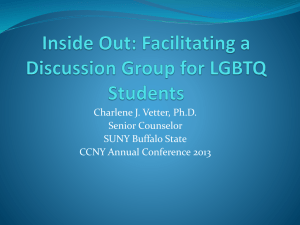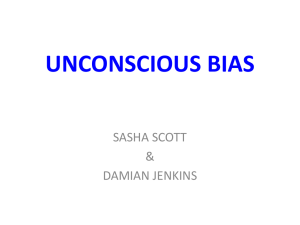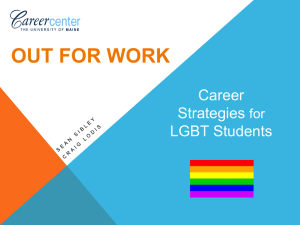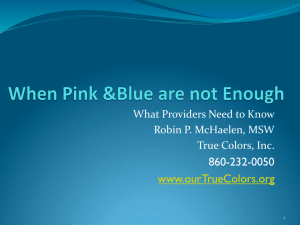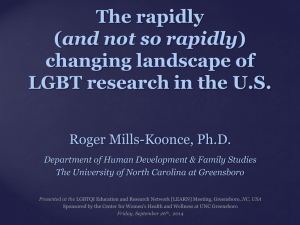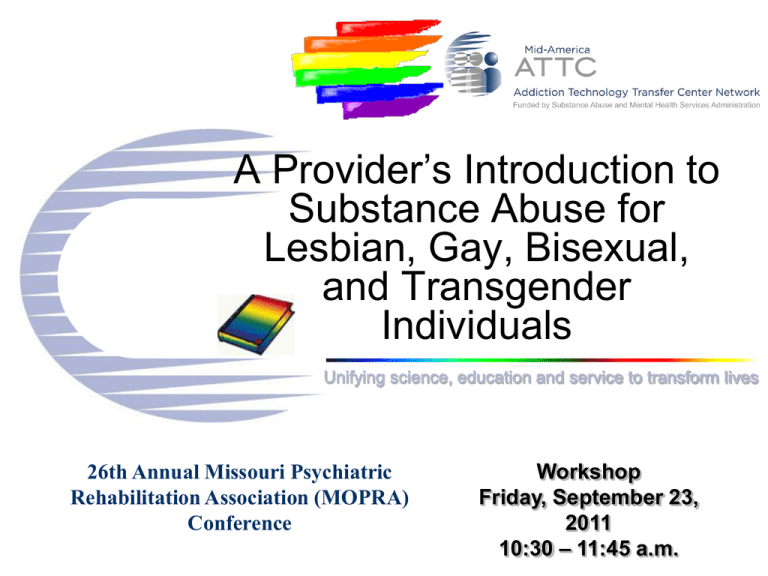
A Provider’s Introduction to
Substance Abuse for
Lesbian, Gay, Bisexual,
and Transgender
Individuals
26th Annual Missouri Psychiatric
Rehabilitation Association (MOPRA)
Conference
Workshop
Friday, September 23,
2011
10:30 – 11:45 a.m.
Unifying science, education and services to transform lives.
Facilitator
Jan Wrolstad, M. Div.
Associate Director
Mid-America Addiction Technology Transfer Center
Institute for Human Development
University of Missouri-Kansas City
wrolstadj@umkc.edu
816.235.5056
A Provider’s Introduction to Substance Abuse for LGBT Individuals
Module 1 - An Overview for
Providers Treating LGBT Clients
A Provider’s Introduction to
Substance Abuse for Lesbian,
Gay, Bisexual, and
Transgender Individuals
First Edition
PowerPoint Slide #1- 0
Unifying science, education and services to transform lives.
DISCUSSION: How many LGBTQ
clients are in your treatment facility?
– How many clients does your
facility/agency/ organization see/treat
on a monthly or annual basis?
– Of those, how many are "out" to you
as lesbian, gay, bisexual, or
transgender?
– How many are out as LGBT to
everyone in the treatment setting?
PowerPoint Slide # 1-2
A Provider’s Introduction to Substance Abuse for LGBT Individuals
Module 1 Overview
Unifying science, education and services to transform lives.
DISCUSSION, cont.: How many LGBTQ
clients are in your treatment facility?
– Does the number of LGBTQ clients who
are out realistically reflect how many
LGBTQ persons are actually being served
in your setting? Why or why not?
– What is the potential of your agency to
serve more LGBTQ clients?
– Why is it important to LGBTQ clients to
address identity in the context of
treatment for substance use disorders?
PowerPoint Slide # 1-2a
A Provider’s Introduction to Substance Abuse for LGBT Individuals
Module 1 Overview
Unifying science, education and services to transform lives.
Historical Perspectives on
Homosexuality & Bisexuality
• 1870s
- Homosexuality, as a specific category, not
described in medical or psychiatric literature until
1870s.
• 1940s and 1950s - Same-sex sexual attraction and
behavior was a mental disorder.
• 1957- Dr. Evelyn Hooker’s landmark study finds gays
and lesbians “normal.”
• 1969- The Stonewall Riots in New York City.
• 1973 - The American Psychiatric Association
removes homosexuality as psychopathology from the
DSM.
Power Point Slide # 1-4
A Provider’s Introduction to Substance Abuse for LGBT Individuals
Module 1 Overview
Unifying science, education and services to transform lives.
TERMS in CATEGORIES
SEX
Male
Female
Intersex
GENDER
Male / Masculine
Female / Feminine
GENDER ROLE
Male / Masculine
Female / Feminine
GENDER IDENTITY
Transgender
Transsexual
Male
Female
Queer
Intersex
SEXUAL ORIENTATION
Lesbian
Gay
Bisexual
Heterosexual
Queer
Questioning PowerPoint Slide #1- 11
A Provider’s Introduction to Substance Abuse for LGBT Individuals
Module 1 Overview
Unifying science, education and services to transform lives.
Men Who Have Sex with Men (MSM)
Does not include just gay or bisexual men
Used as a term to define a broader category of
persons and includes both heterosexual and
homosexual men
Research is currently being conducted within
this population group
A Provider’s Introduction to Substance Abuse for LGBT Individuals
Module 1 Overview
Unifying science, education and services to transform lives.
Demographics of Sexual Orientation
Difficult to establish for a variety of reasons:
Rely on self-report
Variance in research questions
1.
2.
3.
4.
Self-reporting of same-sex desires
Self-reporting of one-time same-sex sexual experiences
Self-reporting of multiple same-sex sexual experiences
Self-reporting of identification as gay, lesbian or bisexual
Differing ideas about what constitutes a
“sexual act”
Difference between sexual orientation & gender
identification
A Provider’s Introduction to Substance Abuse for LGBT Individuals
Module 1 Overview
Unifying science, education and services to transform lives.
Value of Reliable Demographics
in Informing Public Policy
Calculating costs and benefits of domestic
partnership benefits
Impact of legalizing gay unions and adoptions
by gay persons
Impact of rescinding U.S. military “Don’t Ask,
Don’t Tell” policy
Provide valuable information for revamping
health and behavioral health systems
Improve best practices in SUD and MH services
for the LGBTQ population
A Provider’s Introduction to Substance Abuse for LGBT Individuals
Module 1 Overview
Unifying science, education and services to transform lives.
The Kinsey Scale
Two famous studies of demographics of
human sexual orientation were Dr. Alfred
Kinsey’s:
Sexual Behavior in the Human Male (1948)
Sexual Behavior in the Human Female (1953)
Used a 7-point spectrum to define sexual
behavior
PowerPoint Slide # 1-5a
A Provider’s Introduction to Substance Abuse for LGBT Individuals
Module 1 Overview
Unifying science, education and services to transform lives.
The Kinsey Scale
0 Exclusively heterosexual
1 Predominantly heterosexual, incidentally
homosexual
2 Predominantly heterosexual but more than
incidentally homosexual
3 Equal heterosexual and homosexual
4 Predominantly homosexual, but more than
incidentally heterosexual
5 Predominantly homosexual , incidentally
heterosexual
6 Exclusively homosexual
PowerPoint Slide # 1-5
A Provider’s Introduction to Substance Abuse for LGBT Individuals
Module 1 Overview
Unifying science, education and services to transform lives.
The Kinsey Scale
Kinsey results disputed:
1954—John Tukey, Frederick Mosteller, William G.
Cochran—stated that Kinsey based results on
convenience samples rather than random samples
1979—Paul Gebhard (Kinsey’s successor) and Alan
B. Johnson—concluded that none of the original
estimates were significantly affected by the
perceived bias
PowerPoint Slide # 1-5b
A Provider’s Introduction to Substance Abuse for LGBT Individuals
Module 1 Overview
Unifying science, education and services to transform lives.
Demographic Surveys
Centers for Disease Control (CDC) Study (1989): selfidentification of bisexuality in men who have sex with men at
54% in African Americans, 44% in Hispanics and 11% in white
men.
Michaels, S. (1996): indicating 10% of men and 5% of women
identifying as engaging in same-gender sexual behaviors
Seil, D. (1996): Transgender studies - 15% in general
population but culled only from mental health data.
Centers for Disease Control (CDC) Study (2002): 4% of
females had a sexual experience with another female in the
past 12 months. 11% of women had a same-sex sexual
experience in their lifetime. 2.8% of women Identify selves as
bisexual
Bockting, W.O. (2003): More recent data from studies on HIV
risk indicate 6% identification on the transgender spectrum.
PowerPoint Slide # 1-6
A Provider’s Introduction to Substance Abuse for LGBT Individuals
Module 1 Overview
Unifying science, education and services to transform lives.
Research from The Williams Institute on
Sexual Orientation/ UCLA School of Law
Research paper: Same-sex Couples and the Gay,
Lesbian, Bisexual Population: New Estimate from the
American Community Survey
Comparative
1.
2.
data taken from 2 sources:
U.S. Census 2000
American Community Survey (ACS) 2005
Number
of same-sex couples in the U.S. grew by more than 30 percent
from 2000 to 2005, from nearly 600,000 couples to almost 777,000.
1.
2.
In
More LGB may be choosing to couple with same-sex partners
Larger numbers may be willing to report their relationship
Midwest states:
1.
2.
3.
4.
Nebraska—71% increase
Kansas—68% increase
Iowa—58% increase
Missouri—56% increase
A Provider’s Introduction to Substance Abuse for LGBT Individuals
Module 1 Overview
Unifying science, education and services to transform lives.
Research from The Williams Institute on
Sexual Orientation/ UCLA School of Law
Research paper: Same-sex Couples and the Gay,
Lesbian, Bisexual Population: New Estimate from the
American Community Survey (2011)
Estimates of percentage of GLB
population:
1. Missouri—3.8%
2. Kansas—3.6%
3. Nebraska—3.4%
4. Iowa—2.8%
A Provider’s Introduction to Substance Abuse for LGBT Individuals
Module 1 Overview
Unifying science, education and services to transform lives.
Estimate of LGBT persons
in the U.S.
3.8% identify as gay, lesbian,
bisexual or transgender
–1.8% identify as bisexual
–1.7% identify as gay or lesbian
–0.3% identify as transgender
10%—most widely accepted
percentage
some research estimates 20%
from Williams Institute, UCLA School of Law, 2011
A Provider’s Introduction to Substance Abuse for LGBT Individuals
Module 1 Overview
Unifying science, education and services to transform lives.
Estimate of Transsexual
persons in the U.S.
1
per 20,000 to 50,000 persons
More
transsexual women (male to
female) than transsexual women (male
to female)
from Weitze & Osburg, 1996
A Provider’s Introduction to Substance Abuse for LGBT Individuals
Module 1 Overview
Unifying science, education and services to transform lives.
Substance Abuse Study
Characteristics of lesbian, gay, bisexual, and transgender
individuals entering substance abuse treatment
RESEARCHERS:
Bryan N. Cochran, Ph.D., Department of Psychology, University of Montana, Missoula, Montana
Ana Mari Cauce, Ph.D., Department of Psychology, University of Washington, Seattle, Washington
PUBLISHED:
Journal of Substance Abuse Treatment: March 2006; vol. 30, no. 2; pp. 135-146
See handout on JSAT research article.
PowerPoint Slide # 1-7a
A Provider’s Introduction to Substance Abuse for LGBT Individuals
Module 1 Overview
Module 2:
Cultural Issues for LGBT Clients
A Provider’s Introduction to
Substance Abuse for Lesbian,
Gay, Bisexual, and
Transgender Individuals
First Edition
Unifying science, education and services to transform lives.
HOMOPHOBIA and HETEROSEXISM
Homophobia is an irrational fear of gay and lesbian people
or fear of same-sex relationships. In its most extreme form,
homophobia is a hatred for or violence against LGBT
persons.
Heterosexism is an assumption of heterosexuality and the
heterosexual perspective as the predominant or meaningful
viewpoint.
Biphobia is fear of and hatred for bisexuality.
Transphobia is fear of and hatred for transgender persons.
PowerPoint Slide # 2-4
A Provider’s Introduction to Substance Abuse for LGBT Individuals
Module 2 Cultural Issues
Unifying science, education and services to transform lives.
Levels of Acculturation: accommodation to the
rules and expectations of the majority culture
without entirely giving up cultural identity
Assimilated—An assimilated person has consciously or
subconsciously rejected his or her culture of origin (ethnicity)
in favor of an adopted culture.
Bi-cultural/cultural multiplicity—Bi-cultural or cultural
multiplicity are terms used to describe persons who are
integrated into a new cultural and social group, but function
in the society and norms of the dominant culture as well.
Culturally immersed—Culturally immersed individuals have
rejected mainstream culture, and their emotional and
spiritual needs are met exclusively in their new community.
Traditional—Carriers of a community ethos. They neither
overtly accept nor reject their ethnic identity. Have limited
contact with the dominant culture or any outside
PowerPoint Slide # 2-8a
communities.
A Provider’s Introduction to Substance Abuse for LGBT Individuals
Module 2 Cultural Issues
Unifying science, education and services to transform lives.
Core Aspects of Identity
Family of Origin
Race
Ethnicity
Age
Class
Sexual Orientation
Gender Identity
Abilities
Appearance
Religion
Other
PowerPoint Slide # 2-2
A Provider’s Introduction to Substance Abuse for LGBT Individuals
Module 2 Cultural Issues
Module 3:
Legal Issues for Programs Treating
LGBT Clients
A Provider’s Introduction to
Substance Abuse for Lesbian,
Gay, Bisexual, and
Transgender Individuals
First Edition
Unifying science, education and services to transform lives.
Confidentiality
Vol. 42 of the Code of Federal Regulations [CFR], Part 2
No disclosure without consent about anyone who
has applied for or received any substance abuserelated assessment, treatment, or referral services
Applies from the time an individual makes an
appointment
Applies to former clients
Prohibits disclosure of information that would
identify the individual either directly or by
implication as a substance abuser.
PowerPoint Slide # 3-2
A Provider’s Introduction to Substance Abuse for LGBT Individuals
Module 3 Legal Issues
Unifying science, education and services to transform lives.
Use of Consent and
Disclosure Without Consent
CONSENT MUST BE USED:
To seek information from collateral sources
To make periodic reports or coordinate care
To make referrals
DISCLOSURE WITHOUT CONSENT:
Medical emergency
Child abuse mandated reporting
Communications between program staff
Important Note: Disclose information with caution, consequences of
disclosure may be detrimental to the client.
PowerPoint Slide # 3-4
A Provider’s Introduction to Substance Abuse for LGBT Individuals
Module 3 Legal Issues
Unifying science, education and services to transform lives.
What Treatment Programs
Can Do To Help LGBT Clients
Confidentiality
Respect for LGBT
Clients
Caution on Self–
Disclosure
Program Safety for
LGBT Individuals
Educate Staff and
Clients
Affirmative
Action/Cultural
Competence
Legal Inventory
PowerPoint Slide # 3-6
A Provider’s Introduction to Substance Abuse for LGBT Individuals
Module 3 Legal Issues
Module 4:
An Overview of Treatment Approaches,
Modalities, and Issues of Accessibility
in the Continuum of Care
A Provider’s Introduction to
Substance Abuse for Lesbian,
Gay, Bisexual, and
Transgender Individuals
First Edition
Unifying science, education and services to transform lives.
Approaches, Levels and
Continuum of Care, and Access to
Treatment
Treatment-readiness approaches
– Sexual orientation and gender identity issues
– Coming out
– Social stigma and discrimination
– Health concerns, such as HIV/AIDS
– Homophobia and heterosexism
Level of care
– Residential versus outpatient
– LGBT community-based support services
Continuum of care
LGBT-specific versus mainstream
A Provider’s Introduction to Substance Abuse for LGBT Individuals
PowerPoint Slide # 4-2
Module 4 Treatment Approaches
Unifying science, education and services to transform lives.
LGBT Client Do's and Don'ts
• Staff Sensitivity
o Knowledge, skills, and attitudes
• Assessment Practices and
Issues
• Facilities and Modalities
o For example, room assignments and
shared bathrooms
o Individual, group, and family
interventions
• Discharge and Aftercare
A Provider’s Introduction to Substance Abuse for LGBT Individuals
PowerPoint Slide # 4-3
Module 4 Treatment Approaches
Unifying science, education and services to transform lives.
Defining
Care
LGBT-tolerant
Aware that LGBT people exist and use their services
LGBT-sensitive
Aware of, knowledgeable about, and accepting of LGBT
people
LGBT-affirmative
Actively promote self-acceptance of an LGBT identity as
a key part of recovery
PowerPoint Slide # 4-4
A Provider’s Introduction to Substance Abuse for LGBT Individuals
Module 4 Treatment Approaches
Unifying science, education and services to transform lives.
Special Assessment Questions
Level of comfort being LGBT person ?
Stage of coming out ?
Family/support/social network ?
Health factors ?
Milieu of use ?
Drug use and sexual identity or sexual behavior
connections ?
Partner/lover use ?
Legal problems related to sexual behavior ?
Victim of gay bashing ?
Same-gender domestic violence ?
Out as LGBT in past treatment experiences ?
Correlates of sober periods ?
PowerPoint Slide # 4-5
A Provider’s Introduction to Substance Abuse for LGBT Individuals
Module 4 Treatment Approaches
Unifying science, education and services to transform lives.
Family Influences
1.
What are the important values and major
influences, positive and negative, that you
received from your families while growing up?
2.
How do these family influences affect our
lives?
3.
How might all of these family values and
influences affect a client’s relapse patterns
and/or recovery?
Power Point Slide #6-2, n12
A Provider’s Introduction to Substance Abuse for LGBT Individuals
Clinicians Guide, Part 2 of 2
Unifying science, education and services to transform lives.
Taking a Family History
All Clients:
What were the rules of the
family system?
Was there a history of
physical, emotional, spiritual,
or sexual trauma?
Were all family members
expected to behave or evolve
in a certain way?
What were the family’s
expectations in regard to
careers, relationships,
appearance, status, or
environment?
In general, was sex ever
discussed?
LGBT Clients:
Was anyone else in the family
acknowledged to be or
suspected of being a lesbian,
gay, bisexual, or transgender
individual?
How did the family respond to
other individuals coming out or
being identified as LGBT
individuals?
Is the client out to his or her
family?
If the client is out, what type of
response did he or she
receive?
Power Point Slide # 6-4, n14
A Provider’s Introduction to Substance Abuse for LGBT Individuals Clinician’s Guide: Part 2 of 2
Unifying science, education and services to transform lives.
Modalities
Group counseling—may be difficult
Family counseling—may be difficult
Individual counseling
Research-based Interventions
PROP (Positive Reinforcement Opportunity Project)
– low-intensity contingency management intervention in both outpatient
and community settings
– Preliminary efficacy at reducing methamphetamine use (Shoptaw et
al, 2006)
Gay-Specific CBT Groups (Shoptaw, 2005)
– Significantly reduced depressive symptoms in sample of
methamphetamine-dependant gay and bisexual men
PowerPoint Slide # 4-6
A Provider’s Introduction to Substance Abuse for LGBT Individuals
Module 4 Treatment Approaches
Module 5
The Coming Out Process
for Lesbians and Gay Men
A Provider’s Introduction to
Substance Abuse for Lesbian,
Gay, Bisexual, and
Transgender Individuals
First Edition
Unifying science, education and services to transform lives.
to Working With Lesbian, Gay, Bisexual, and
Transgender Clients in Substance Abuse Treatment
1.
2.
3.
4.
5.
Understand the "coming out" process and its
impact
Understand clinical issues and effective
interventions with lesbians, gay men, bisexuals,
transgender individuals, and LGBT youth
Have skills for working with LGBT families
Be able to identify and assess related health and
mental health issues
Demonstrate skills for evaluating and improving
counselor competence in treating LGBT clients
Power Point Slide # 5-1
A Provider’s Introduction to Substance Abuse for LGBT Individuals
Module 5 -12 Clinician’s Guide
Unifying science, education and services to transform lives.
The term "coming out" refers to the
experiences of lesbians and gay men as they
work through and accept a stigmatized
identity, transforming a negative self-identity
into a positive one.
Power Point Slide # 5-4
A Provider’s Introduction to Substance Abuse for LGBT Individuals
Module 5 -12 Clinician’s Guide
The CASS Model
Unifying science, education and services to transform lives.
Stage I: Identity Confusion
Occurs when a person begins to realize that he/she may
relate to or identify as being gay or lesbian, a process of
personalizing the identity.
–
–
–
–
Tasks:
Feelings:
Defenses:
Recovery:
Exploration and increasing awareness
Anxiety, confusion
Denial
Having a confidential support person
Power Point Slide # 5-5
A Provider’s Introduction to Substance Abuse for LGBT Individuals
Module 5 -12 Clinician’s Guide
The CASS Model
Unifying science, education and services to transform lives.
Stage II: Identity Comparison
Occurs when a person accepts the possibility the he/she
might be gay or lesbian.
– Tasks:
– Feelings:
– Defenses:
– Recovery:
Exploration of implications,
encountering others like oneself
Anxiety, excitement
Bargaining and rationalizing
Meeting gays/ lesbians/
bisexuals/transgender persons in
recovery
Power Point Slide # 5-6
A Provider’s Introduction to Substance Abuse for LGBT Individuals
Module 5 -12 Clinician’s Guide
The CASS Model
Unifying science, education and services to transform lives.
Stage III: Identity Tolerance
Occurs when a person comes to accept the probability
that he/she is an LGBT person.
Tasks:
Feelings:
Defenses:
Recovery:
Recognizing social and
emotional needs as a gay man or
lesbian
Anger, excitement
Reactivity
How to be gay, lesbian, bisexual,
or transgender and stay
sober
Power Point Slide # 5-7
A Provider’s Introduction to Substance Abuse for LGBT Individuals
Module 5 -12 Clinician’s Guide
The CASS Model
Unifying science, education and services to transform lives.
Stage IV: Identity Acceptance
Occurs when a person fully accepts rather than
tolerates himself or herself as an LGBT person.
Tasks:
Development of community and
acculturation
Feelings:
Rage and sadness
Defenses:
Hostility towards straight culture
Recovery:
Lesbian/gay/bisexual/
transgender recovering
community building
)
A Provider’s Introduction to Substance Abuse for LGBT Individuals
Power Point Slide # 5-8
Module 5 -12 Clinician’s Guide
The CASS Model
Unifying science, education and services to transform lives.
Stage V: Identity Pride
Occurs when the person immerses himself or herself
in the LGBT community and culture to live out
identity totally
Tasks:
Feelings:
Defenses:
Recovery:
Full experience of being an
LGBT person, confronting
internalized homophobia
Excitement and focused anger
Arrogant pride and rejection of
straight culture as the norm
Integrating sexuality, identity, and
recovery
Power Point Slide # 5-9
A Provider’s Introduction to Substance Abuse for LGBT Individuals
Module 5 -12 Clinician’s Guide
The CASS Model
Unifying science, education and services to transform lives.
Stage VI: Identity Synthesis
Occurs when a person develops a fully internalized
and integrated LGBT identity and experiences
himself or herself as whole when interacting with
everyone across all environments.
Tasks:
Coming out as fully as possible,
intimate gay and lesbian relationship;
self-actualization as a gay man,
lesbian, bisexual, or transgender
person
Feelings:
Excitement and happiness
Defenses:
Minimal
Recovery:
Maintenance (end stage)
Power Point Slide # 5-10
A Provider’s Introduction to Substance Abuse for LGBT Individuals
Module 5 -12 Clinician’s Guide
Unifying science, education and services to transform lives.
Neisen's 3-Phase Model for Recovery From Shame –
Phase I: Breaking the Silence
Parallels the process of coming out. It is important for
LGBT individuals to tell their stories and to address the
pain of being different in a heterosexist society.
Counselor Tasks:
1. Facilitate client discussion of hiding LGBT feelings from
others
2. Explore emotional costs of hiding/denying one's
sexuality
3. Discuss how the client has tried to fit in and at what cost
4. Examine negative feelings of self-blame, feeling bad or
sick, and the effect of shaming messages on client
5. Foster client's ability to be out
Power Point Slide # 5-11
A Provider’s Introduction to Substance Abuse for LGBT Individuals
Module 5 -12 Clinician’s Guide
Unifying science, education and services to transform lives.
Neisen’s 3-Phase Model for Recovery from Shame
Phase II: Establishing Perpetrator Responsibility
Allows clients to understand their struggle in the
context of societal discrimination and prejudice.
Counselor Tasks:
1.
Facilitate focusing and, managing anger constructively,
not destructively
2.
Help client understand and accept negative self-image
as socio cultural, not personal
3.
Counteract client's experience of heterosexism and
homophobia by role-modeling and by providing a
treatment environment that is empowering for LGBT
persons, not stigmatizing.
Power Point Slide # 5-12
A Provider’s Introduction to Substance Abuse for LGBT Individuals
Module 5 -12 Clinician’s Guide
Unifying science, education and services to transform lives.
Neisen’s 3-Phase Model for Recovery from Shame
Phase III: Reclaiming Personal Power
Involves improving self-concept, self-esteem, and selfconfidence
Counselor Tasks:
1.
Facilitate client's self-concept and self-efficacy
2.
Identify and change negative messages to affirmations
3.
Recognize and release residual shame
4.
Develop a positive affirming spirituality
5.
Integrate public and private identities
6.
Build a support network, connect to community
Power Point Slide # 5-13
A Provider’s Introduction to Substance Abuse for LGBT Individuals
Module 5 -12 Clinician’s Guide
Module 7
Clinical Issues with Lesbians
A Provider’s Introduction to
Substance Abuse for Lesbian,
Gay, Bisexual, and
Transgender Individuals
First Edition
Unifying science, education and services to transform lives.
Myth: You can tell a lesbian by how she looks.
Fact: Lesbian appearances are diverse. Some
women may look or act masculine; other women
may look or act feminine. Not all lesbians are
“butch”.
Power Point Slide # 7-2, n15
A Provider’s Introduction to Substance Abuse for LGBT Individuals
Module 5 -12 Clinician’s Guide
Unifying science, education and services to transform lives.
Myth: Lesbians hate men, are afraid of men, or
want to be men.
Fact: Most lesbians do not hate, fear, or want to
be men. Most lesbians have relationships with
men in a variety of roles: family, friends,
colleagues, coparents, etc.
Power Point Slide # 7-3, n16
A Provider’s Introduction to Substance Abuse for LGBT Individuals
Module 5 -12 Clinician’s Guide
Unifying science, education and services to transform lives.
Myth: Lesbians do not form stable relationships.
Fact: Like their straight counterparts, some
lesbians engage in serial dating and are not
monogamous; some are in long-term
partnerships.
Power Point Slide # 7-4, n17
A Provider’s Introduction to Substance Abuse for LGBT Individuals
Module 5 -12 Clinician’s Guide
Unifying science, education and services to transform lives.
Myth: A lesbian identity is about sex.
Fact: Although being lesbian certainly is about
being sexually attracted to other women, many
lesbians also talk about the power and
importance of their emotional and affectional
feelings and attractions for other women. In
addition, there is a lesbian cultural identity.
Power Point Slide # 7-5, n18
A Provider’s Introduction to Substance Abuse for LGBT Individuals
Module 5 -12 Clinician’s Guide
Unifying science, education and services to transform lives.
Myth: Sexual abuse by men or bad relationships
with men causes lesbianism.
Fact: There is no research that suggests sexual,
physical, or emotional abuse by men causes
lesbianism.
Power Point Slide # 7-6, n19
A Provider’s Introduction to Substance Abuse for LGBT Individuals
Module 5 -12 Clinician’s Guide
Unifying science, education and services to transform lives.
Myth: Lesbianism is caused by a hormonal
imbalance and could be changed by taking the
right hormones.
Fact: There is no evidence to support a
relationship between sexual orientation and
hormonal levels.
Power Point Slide # 7-7, n20
A Provider’s Introduction to Substance Abuse for LGBT Individuals
Module 5 -12 Clinician’s Guide
Unifying science, education and services to transform lives.
Special Issues for Lesbians
1.
Multiple stigmas and stressors related to
sexism, lesbian identity, and substance use
2.
Relationships as a major treatment focus
for all lesbians
3.
Relapse to protect themselves from painful
feelings surrounding their sexuality
Power Point Slide # 7-8, n21
A Provider’s Introduction to Substance Abuse for LGBT Individuals
Module 5 -12 Clinician’s Guide
Module 8
Clinical Issues with Gay Male Clients
A Provider’s Introduction to
Substance Abuse for Lesbian,
Gay, Bisexual, and
Transgender Individuals
First Edition
Unifying science, education and services to transform lives.
Myth: Gay men appear and act more feminine.
Fact: Gay male appearances and behaviors are
diverse. Some men may look or act
hypermasculine; other men may look or act in a
manner more associated with being feminine.
Power Point Slide # 8-2, n23
A Provider’s Introduction to Substance Abuse for LGBT Individuals
Module 5 -12 Clinician’s Guide
Unifying science, education and services to transform lives.
Myth: Same-sex sexual behaviors can often be
blamed on using alcohol and drugs; once the
client achieves sobriety, he will no longer desire
or seek same-sex sexual relations.
Fact: Many gay men report using alcohol and
drugs to cope with their guilt and shame about
same-sex sexual desire and behaviors.
Power Point Slide # 8-3, n24
A Provider’s Introduction to Substance Abuse for LGBT Individuals
Module 5 -12 Clinician’s Guide
Unifying science, education and services to transform lives.
Myth: Gay men are not interested in or are unable
to engage in committed relationships, only in
sexual encounters.
Fact: More gay men these days report seeking or
being in long-term committed relationships with
partners, and many gay male couples are
parenting children.
Power Point Slide # 8-4, n25
A Provider’s Introduction to Substance Abuse for LGBT Individuals
Module 5 -12 Clinician’s Guide
Unifying science, education and services to transform lives.
Myth: Most gay men are overly enmeshed with
their mothers and have cold or indifferent
fathers.
Fact: Many gay men had "normal" family
relationships; some had excellent relationships
with both parents, and some had terrible
relationships with both parents.
Power Point Slide # 8-5, n26
A Provider’s Introduction to Substance Abuse for LGBT Individuals
Module 5 -12 Clinician’s Guide
Unifying science, education and services to transform lives.
Special Issues for Gay Men
1.
Linking of substance abuse and sexual expression
2.
Internalized homophobia
3.
The role of sexual abuse and violence
4.
Limited social outlets
5.
Geographic and cultural differences have an
important impact on the lives of gay men
6.
Limited role models and deeply ingrained
stereotypes
7.
Substance use and HIV/AIDS.
A Provider’s Introduction to Substance Abuse for LGBT Individuals
Power Point Slide # 8-6, n27
Module 5 -12 Clinician’s Guide
Module 11
Clinical Issues with Youth
A Provider’s Introduction to
Substance Abuse for Lesbian,
Gay, Bisexual, and
Transgender Individuals
First Edition
Unifying science, education and services to transform lives.
Adolescent Statistics
20 to 40% of homeless youth identify as LGBTQI2S
62% of LGBTQI2S homeless youth have attempted suicide
(29% of heterosexual homeless youth have attempted suicide)
75% of LGBTQI2S homeless youth have histories of substance
abuse (63% of heterosexual homeless youth have histories of substance
abuse)
LGBTQI2S homeless youth experience an average of 3.2 more acts
of sexual violence than their heterosexual peers
from SAMHSA Homelessness Resource Center
A Provider’s Introduction to Substance Abuse for LGBT Individuals
Module 2 Cultural Issues
Unifying science, education and services to transform lives.
It Gets Better Project
www.itgetsbetter.org
A Provider’s Introduction to Substance Abuse for LGBT Individuals
Module 2 Cultural Issues
Unifying science, education and services to transform lives.
It Gets Better Project
It Gets Better: Dan and Terry:
http://www.itgetsbetter.org/pages/about-it-gets-better-project/
It Gets Better: San Francisco Giants:
http://www.itgetsbetter.org/blog/entry/san-francisco-giants-becomefirst-professional-sports-team-to-join-the-it-g/
It Gets Better: Janet Mock’s Transformative Journey:
http://www.youtube.com/watch?v=g0t-Ft-vRUE
It Gets Better: President Obama:
http://www.youtube.com/watch?v=geyAFbSDPVk
It Gets Better: UMKC Pride:
http://www.youtube.com/watch?v=w1CF0wGC_oU&playnext=1&list=
PL302B5931520BD4B1
A Provider’s Introduction to Substance Abuse for LGBT Individuals
Module 2 Cultural Issues
Unifying science, education and services to transform lives.
There is
overwhelming
evidence that verbal
and physical
violence against
LGBT youth of all
backgrounds can
lead to high-risk
behaviors that
increase their risk
for substance abuse
and HIV/AIDS
TRUE
Youth who were victims of
bias related harassment
and/or violence are:
Twice as likely to report
bingeing on alcohol (5-plus
drinks at one time) at least
once in the past month
Twice as likely to report
using marijuana in the past
month
Three to ten times as likely
to report having tried
cocaine
Two to three times as likely
to report having ever tried
hallucinogens, depressants
or stimulants
Report of the Anti-Violence Documentation Project
from the Safe Schools Coalition of Washington
(1997).
Power Point Slide # 11-3, n3
A Provider’s Introduction to Substance Abuse for LGBT Individuals
Clinicians Guide, Part 2 of 2
Unifying science, education and services to transform lives.
Reports of higher
rates of suicidal
behaviors and
suicide among
LGBT youth have
not been supported
in the research on
adolescent suicide.
The Youth Risk Behaviors Survey in
the States of Vermont and
Massachusetts (2000) found that
LGBT youth are
FALSE
Twice as likely to report
having seriously considered
suicide in the past year.
Twice as likely to say they
made a suicide plan in the
past year.
Three to four times as likely
to report having attempted
suicide in the past year.
More than four times as
likely to say they made a
serious enough suicide
attempt in the past year to
have been treated by a
health care professional.
Power Point Slide # 11-4, n4
A Provider’s Introduction to Substance Abuse for LGBT Individuals
Clinicians Guide, Part 2 of 2
Unifying science, education and services to transform lives.
LGBT adolescents
are twice as likely as
straight students to
feel unsafe or afraid
at school, some,
most, or all of the
time.
TRUE
97% of students in public
high schools report
regularly hearing
homophobic remarks from
their peers.
LGBT youth are two to four
times more likely than their
heterosexual peers to have
been threatened or injured
with a weapon at school.
34% of lesbian, gay, and
bisexual students surveyed
had been the target of
verbal assaults at school or
en route to or from classes.
Power Point Slide # 11-5, n5
A Provider’s Introduction to Substance Abuse for LGBT Individuals
Clinicians Guide, Part 2 of 2
Unifying science, education and services to transform lives.
School officials and
guidance
counselors are more
aware today of
the need to protect
LGBT youth from
antigay harassment.
Of 289 high school
counselors surveyed in
the Seattle Safe
SchoolsSurvey, one in
six thought there were
no lesbian, gay,
bisexual or transgender
youth in their schools.
20% believed they were
not competent at
counseling LGBT
students
FALSE
Power Point Slide # 11-6, 6
A Provider’s Introduction to Substance Abuse for LGBT Individuals
Clinicians Guide, Part 2 of 2
Unifying science, education and services to transform lives.
Exhibit 11-1:
Sexual Identity: Age of Onset
Average Age (Years) Event Occurs
Behavior /
Identity
Earlier Studies*
More Recent Studies**
Males
Females
Males
Females
First awareness
of same-sex
attraction
13
14-16
9
10
First same-sex
experience
15
20
13-14
14-15
First selfidentified as
lesbian or gay
19-21
21-23
14-16
15-16
*Studies of adults who remembered their experiences as children and adolescents
**Studies of adolescents who described their experiences as they were happening or right after they happened
from A Provider’s Introduction . . . . , p. 101
A Provider’s Introduction to Substance Abuse for LGBT Individuals
Power Point Slide #11-8, n8
Clinicians Guide, Part 2 of 2
Unifying science, education and services to transform lives.
Special Issues for LGBT Youth
All LGBT Youth:
LGBT Youth of Color:
Integrating their sexual, racial,
and ethnic identities
Interacting with three
separate communitiesethno-cultural, LGBT, and
mainstream
Managing more than one
stigmatized identity.
Higher risk for depression
and suicide
Homelessness is a particular
concern for LGBT youth with
reports from various studies
showing ranges from 20
percent to 40 percent
Homeless youth are at high
risk for exploitation; e.g.
survival sex (exchanging sex
for food, drugs, or shelter)
LGBT homeless and runaway
youth have many health and
social problems .
Power Point Slide #11-9, n9
A Provider’s Introduction to Substance Abuse for LGBT Individuals
Clinicians Guide, Part 2 of 2
Questions?
Comments?


